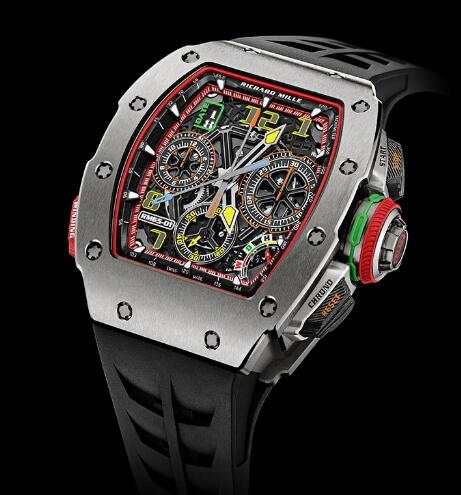Richard Mille RM 50-03 McLaren F1: The world’s lightest minute-seconds tourbillon chronograph

There was only one new timepiece from Richard Mille at the SIHH Watch Salon last week, but it’s pretty awesome. With its RM 50-03 McLaren F1 model – which debuted as the world’s lightest split-seconds chronograph tourbillon watch, weighing less than 40 grams including strap – the brand brings yet another high-tech Material introduced to watchmaking: Graph TPT, also known as graphene.
Graphene was first isolated back in 2004 by Professor Andre Geim from the School of Physics and Astronomy at the University of Manchester. He and his colleague Professor Konstantin Novoselov were awarded the Nobel Prize for this discovery in 2010 and at the University in 2015. Collaborative research between the Institute, McLaren Applied Technologies and North Thin Ply Technology (NTPT) has resulted in a case machined in a modified form of carbon TPT, the physical properties of which have been enhanced by the introduction of graphene .
Graphene, a nanomaterial six times lighter and 200 times stronger than steel, is currently the focus of work between McLaren Technology Group and McLaren Honda to bring the material to McLaren Grand Prix cars . Richard Mille’s timepieces have long shown motorsport influences in their designs and materials, and he sees graphene’s physical properties as significantly reducing the density of its carbon composite case while increasing its a means of resistance.
Carbon TPT, first introduced to the watch industry by copy Richard Mille in 2013, consists of 600 layers of parallel carbon filaments, each no thicker than 30 microns, impregnated with a supercharged resin and compiled by a CNC machine, where the fibers are inserted between the layers The direction changes by 45°. The composite was then heated to 120 degrees Celsius under 6 bar pressure to cure it. Graphene is added to the resin mixture, and the end result is a material known as Graph TPT, used exclusively in watchmaking by Richard Mille. The Graph TPT case of the RM 50-03 consists of three parts, manipulating the material by creating and programming special ultra-precision cutting tools over a long period of time, with a high degree of durability and extreme lightness, while also exhibiting the same undulating, wooden Grain – like the characteristic stripes on other Richard Mille watches made of carbon TPT.
The movement is also very light – just 7 grams – thanks largely to the use of grade 5 titanium and carbon TPT for the baseplate and bridges, as well as the extreme skeletonisation of these and other components. (Titanium is used extensively in McLaren Racing’s Formula 1 engineering build program to lighten and strengthen chassis and aerodynamic elements, and as a material for transmissions, linkages and valve systems. The sport combines brushed, polished, satin finishes And the soft-polished surfaces are all done by hand. The dial, also made of titanium, requires three hours of angling and polishing.
Carbon fiber TPT is also used for the lateral cage, inspired by the wishbone suspension structure of McLaren-Honda Formula 1 cars, and is attached to the case to support movement without traditional case rings. This unconventional system allows for a perfect fit between the movement and the case and increases resistance: in tests carried out at the Richard Mille workshop, the case movement endured a shock load of 5,000 Gs without incident.
The RM 50-03 McLaren F1 combines the tourbillon escapement with the split-seconds chronograph function in one mechanism, requiring perfect energy transmission. The need to reduce friction prompted Richard Mille’s watchmakers to improve the tooth profiles on the movement’s barrel and gear train, resulting in more balanced torque and optimized output. Torque and 70-hour power reserve are displayed on coloured scales on the front of the watch between 11 o’clock and 1 o’clock.
Other technical and aesthetic touches influenced by McLaren Formula 1 include the skeletonized chronograph pushers, reminiscent of the air intake ducts of McLaren Hondas, and the shape of the crown resembling a racing rim.
After extensive research on the split-seconds clip, Richard Mille developed a new split-seconds mechanism for this watch that reduces the energy consumption of the chronograph by 50% while reducing spindle friction. The six-column wheel that controls each rocker of the split-seconds function is designed to ensure perfectly synchronised movements, clean functional locking and very stable settings.
Graphene and its unique properties are also incorporated into the strap: nanomaterials are added to the rubber strap to increase its elasticity and wear resistance. copy watch for sale